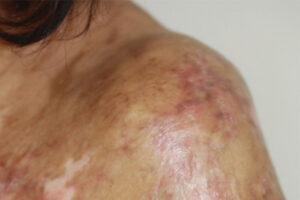Oncology
Chronic Graft-versus-Host Disease
Comparing Chronic Graft-versus-Host Disease in Pediatric and Adult Patients
The clinical manifestations of chronic graft-versus-host disease (cGVHD) are similar in adult and pediatric patients. However, the incidence and severity of cGVHD are generally lower in pediatric patients than in adult patients, and this may be due, in part, to an innate adaptive biology that makes children more tolerant of receiving a foreign graft compared with adults.
I do not work directly with pediatric transplant patients, so this information is general and is based on secondhand reports. That said, the clinical manifestations of cGVHD are very similar in adults and children. You have the same patterns of skin involvement, such as pigment change followed by scarring and scleroderma, loss of hair follicles, and loss of sebaceous glands and their natural oils. The symptoms of joint stiffness and dryness of the eyes and mouth also are very similar in adults and children.
The incidence of cGVHD is generally lower in children than in adults, and children often have less severe manifestations of cGVHD. Typically, the younger a patient is, the lower the risk is for developing cGVHD. This may be related, in part, to the plasticity of the immune system in children. However, in advanced refractory cases, cGVHD in pediatric patients can result in extremely significant functional and quality-of-life deficits, and impactful therapy would have an even more meaningful benefit on a quality-adjusted life expectancy benefit basis.
In addition to biological differences, there also may be disease-related reasons for the overall lower rate and severity of cGVHD in children vs adults. In children, a higher proportion of transplants are likely done for benign hematologic conditions, developmental disorders, and inborn errors of immunity. In contrast, the conditions that often require transplants in adults are myelodysplastic syndromes and leukemias.
Importantly, bone marrow grafts are used much more frequently in children than in adults, partly because children need fewer graft cells. It is also easier to harvest bone marrow for a pediatric recipient because you need less bone marrow from the donor. The use of cord blood transplants in children is also increasing and often works well in this age group. A single unit of cord blood may be sufficient for the average child but would likely be insufficient for the average adult. Children also have better thymic function than adults and are thus typically better equipped with more naive T cells to ensure a more tolerant rather than aggressive response toward the host. For all these reasons, the incidence of cGVHD is much lower in pediatric patients than in adult patients.
These differences can also be seen immunologically when adult and pediatric patients are given low-dose interleukin-2 (IL-2) treatment for cGVHD. When evaluating their immunologic profile, pediatric patients have a greater increase in their number of regulatory T cells relative to natural killer (NK) cells. Adults have a much greater increase in NK cells than regulatory T cells compared with children. In pediatric patients, you really see a much more responsive regulatory T-cell compartment. Therefore, I think that children have an innate adaptive biology that makes them more tolerant of receiving a foreign graft compared with adults. My pediatric colleagues are often struck by how well children respond to therapy relative to adults.
Albert MH, Sirait T, Eikema D-J, et al. Hematopoietic stem cell transplantation for adolescents and adults with inborn errors of immunity: an EBMT IEWP study [published correction appears in Blood. 2023;141(18):2284]. Blood. 2022;140(14):1635-1649. doi:10.1182/blood.2023020298
Haroun E, Agrawal K, Leibovitch J, et al. Chronic graft-versus-host disease in pediatric patients: differences and challenges. Blood Rev. 2023:60:101054. doi:10.1016/j.blre.2023.101054
Lertkovit O, Anurathapan U, Hongeng S, Thokanit NS, Pakakasama S. Chronic graft-versus-host disease in children and adolescents with thalassemia after hematopoietic stem cell transplantation. Int J Hematol. 2021;113(4):556-565. doi:10.1007/s12185-020-03055-w
Liang Z, Dong X, Zhang Z, Zhang Q, Zhao Y. Age-related thymic involution: mechanisms and functional impact. Aging Cell. 2022;21(8):e13671. doi:10.1111/acel.13671
Qayed M, Wang T, Hemmer MT, et al. Influence of age on acute and chronic GVHD in children undergoing HLA-identical sibling bone marrow transplantation for acute leukemia: implications for prophylaxis. Biol Blood Marrow Transplant. 2018;24(3):521-528. doi:10.1016/j.bbmt.2017.11.004
Whangbo JS, Kim HT, Mirkovic N, et al. Dose-escalated interleukin-2 therapy for refractory chronic graft-versus-host disease in adults and children. Blood Adv. 2019;3(17):2550-2561. doi:10.1182/bloodadvances.2019000631
Wobma H, Kapadia M, Kim HT, et al. Real-world experience with low-dose IL-2 for children and young adults with refractory chronic graft-versus-host disease. Blood Adv. 2023;7(16):4647-4657. doi:10.1182/bloodadvances.2023009729











